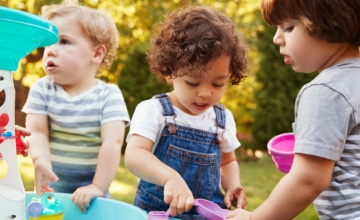Q: Recently, my 3-year-old made the following comments in public: “Mommy, she has a big tummy!” And then, a few days later: “Mommy, that man has brown skin.” What do you do when your child makes embarrassing comments about people? How can I teach her what is and isn’t appropriate?
A: Ah, the joys of parenthood. We can’t wait until our little ones start to talk and can tell us what they are thinking and feeling. Then when they do, it’s not always pretty. It’s natural to feel mortified when your child makes a statement that may hurt another’s feelings. But it’s quite common and, when handled sensitively, these moments can actually be wonderful learning opportunities for your child.
First, it’s important to keep in mind that your child isn’t doing anything wrong. In fact, she’s showing you that she is very observant and notices differences, two very important skills to be successful both academically and socially. For example, these skills helps her understand the difference between different shapes, colors, and sizes—helpful for math. And they help her understand and learn to appreciate and respect the differences in people—a critical social skill. And the fact is that she is not making these statements to be hurtful, something that those who are the subject of her comments know.
When your child makes these kinds of statements, it is important not to react with anger or by shaming. Why? First, it will be confusing to your child who is not purposefully trying to be hurtful. Your anger would indicate that you are assigning malicious meaning to her comment, which is not the case. The wonderful thing is that she does not yet know that a person might feel bad about carrying around extra weight or that different skin color matters. Second, if you react with anger or embarrassment, you are in some way communicating to the target of the comment that they should feel badly about what your daughter has observed.
Instead, say something that validates your daughter’s observation while also modeling tolerance and acceptance of difference. When she comments on someone’s body, you might say, “Yes, people come in all different shapes and sizes. Look at our bellies, how are they different?” When she comments on skin tone, you might say, “People come in all different colors. Let’s look at our faces, what color is yours? What color is mine?” Help her see the different tones in your coloring, for example beige skin, reddish nose, etc.
If your child points at a person and loudly asks, “What is that?” as he points at her prosthetic leg, you can explain, “Great question. She uses a helper leg, called a prosthetic leg, to walk and play.” Keep your answers simple, unemotional, and focused on your child’s question. If your child asks a follow-up question (like “What happened to her leg?”) the goal is again to respond simply and accurately, “Something happened to it that made it not work anymore so a doctor made her a great helper leg.” (Smiling at the person the comment is directed toward can help smooth the way, even if you want to disappear. Rest assured, your child’s will not be the first remark they’ve heard.) Ensuring your response is both respectful and accurate communicates that differences are not disabilities.
By responding in a sensitive and age-appropriate way, you are also taking the most important step in helping teach your child how to be sensitive to other’s feelings and to respect differences, important values in the incredibly rich and diverse world that surrounds us.
Adapted from a column written by ZERO TO THREE in American Baby Magazine.




